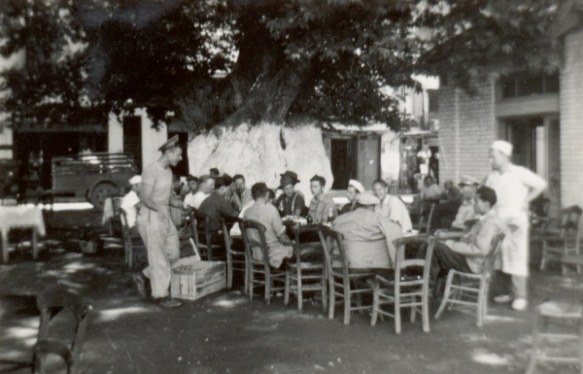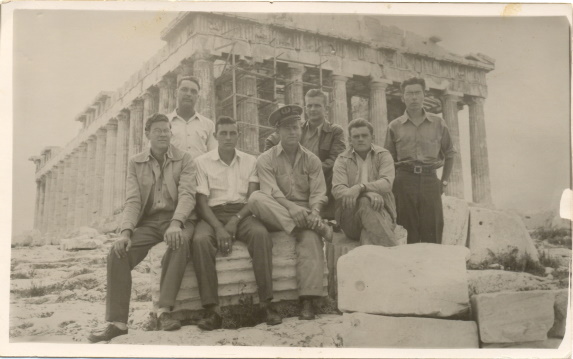
The S. S. Charles W. Wooster preparing to go to Greece, April 1946. Photo courtesy of Perry Bontrager.
The livestock trip of the S. S. Charles W. Wooster started out like any other. On receiving their orders, seagoing cowboys gathered in Houston, Texas, to care for a load of 335 wild Mexican mares bound for Greece. They departed Easter Sunday, April 23, 1946. After an uneventful crossing of the Atlantic and the Mediterranean Sea, the ship docked in Patras, Greece, to unload some of its cargo before going on to Piraeus to unload the rest. In Patras, the ship and the cowboys, however, would go their separate ways.
On arrival in Patras on May 13, cowboy Perry Bontrager was taken with the beauty of the town. “The country is very mountainous,” he notes in his diary. “Some covered with snow. But down around the town, it is really hot.” And not all was beautiful. “It is a sorryful [sic] sight the way some of the people are dressed,” he says. “Little children come with tin cans and want to have them filled with food.”
The next day, about 100 of the horses were unloaded, followed the day after that by some of the sulpher and cotton the ship also carried. “This is to be the last day at Patras,” Bontrager notes. “So about nine tenth of the ship crew went out for a drunk [sic]. Quite a few of the fellows wouldn’t of made it back to the ship if someone wouldn’t of helped them.”
With brains still fogged from their nightly binge, miscommunications caused the ship’s crew to back the vessel into a cement dock jamming the propeller into the rudder. “As a result,” says cowboy Victor Goering, “they had to unload some cargo on to barges and eventually they were able to use the winches to pull us back to where we had been originally.” There, the remainder of the cargo was unloaded.

The S. S. Charles W. Wooster rammed into the dock in Patras, Greece, May 16, 1946. Photo courtesy of Victor Goering.
Unable to proceed on its own power, the Charles W. Wooster was towed to Naples, Italy, for repair. This left the cowboys stranded until UNRRA could make arrangements to return them home, giving them an extra five days to explore and enjoy the city of Patras.
On May 22, “They loaded us into the back of a 4-wheel army truck and with our luggage on a heavy army trailer we headed for Athens,” says cowboy Wilbur Swartzendruber. “This proved to be one of the most dangerous rides I have ever been on. Our veterinarian along with a Greek driver who was intoxicated, slid the trailer around every corner we went around. He crowded a British bread truck off the road and it upset, spilling bread over the countryside. The good Lord surely did look over us on this ride.”

A lunch stop on the way to Athens, May 22, 1946. Luggage trailer in the background. Photo courtesy of Perry Bontrager.
“On the way to Athens,” says Goering, “we saw some effects of the bombing of the railroads. Almost every trestle showed some damage and there were many railcars lying on their sides and completely burned out.”
After their exhausting 150-mile journey, the cowboys settled into the Monrapos Hotel in Amarosa, about 15 miles beyond Athens. Here they would stay for eleven or twelve days until UNRRA found ships for their return trip.

The seagoing cowboys of the S. S. Charles W. Wooster in Amarosa, Greece, May 1946. Photo courtesy of Perry Bontrager.
Given a daily allowance by UNRRA, the cowboys took in the sights of Athenian antiquities, went to movies, and relaxed. An unexpected Greek vacation.
UNRRA’s travel arrangements split the cowboys into a group of twelve returning on June 2 on the S. S. John Jacob Astor and the remaining six departing the next day on the S. S. Paul Hamilton Hayne. Bontrager notes, “We are traveling back as first class passengers.” A luxury other cowboys stuck with cleaning out the stalls on their return trips would envy.
“Our discharge in Newport News, Virginia, on June 24 was a happy one for me,” says Swartzendruber, a John Jacob Astor passenger. “It was my 21st birthday.” A day and a trip to remember!



When I saw the name Perry Bontrager, a bell went off in my brain. Dad, Robert Leach, has died, so I cannot ask him, but the name Bontrager is familiar. Do you know why? I think maybe that was the name of the man in California who was holding the goats at his farm before they were transferred to the cowboys for shipment to Japan. But that is just a guess; The name fits into my dad’s story somewhere, but I’m not sure how. I just know it is the only time I’ve ever heard that last name, and it is connected somehow to HPI. Lovely write-up as always, Peggy. What an extra marvelous adventure these cowboys had. I’m happy for them.
LikeLike
Hi, Kirsten! Good memory! The man who initiated the goats-to-Japan project and worked on it on the California end was Amos Bontrager. Bontrager is a rather common name among the Brethren, Mennonites, and Amish, so I doubt there was any relationship between him and Perry Bontrager. Perry was a farmer from Iowa. It’s always great to hear from you!
LikeLike
Loved this story. Some names are familiar. Perry Bontrager… Schwartzentrooper.
On Fri, Feb 12, 2021, 6:04 AM The Seagoing Cowboys wrote:
> Peggy Reiff Miller posted: ” The livestock trip of the S. S. Charles W. > Wooster started out like any other. On receiving their orders, seagoing > cowboys gathered in Houston, Texas, to care for a load of 335 wild Mexican > mares bound for Greece. They departed Easter Sunday, April 23″ >
LikeLiked by 2 people